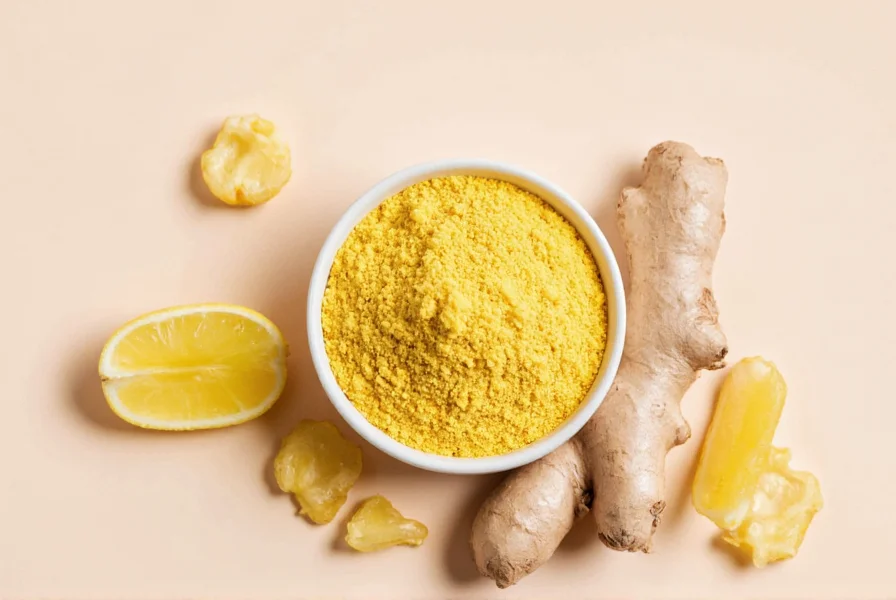Ginger root extract has gained significant attention in both traditional and modern medicine for its concentrated therapeutic properties. Unlike fresh ginger, which contains approximately 0.5-3% gingerols by weight, high-quality extracts standardize these bioactive compounds to ensure consistent potency and efficacy. This standardization process creates a more reliable option for those seeking specific health benefits supported by clinical research.
What Exactly Is Ginger Root Extract?
Ginger root extract is produced through various extraction methods that concentrate the bioactive compounds found naturally in ginger rhizomes. The most common extraction processes include:
- Supercritical CO2 extraction - produces highly concentrated, solvent-free extracts
- Ethanol extraction - preserves a broad spectrum of ginger compounds
- Water-based extraction - creates milder extracts suitable for certain applications
The key difference between ginger root extract and fresh ginger lies in potency and consistency. While fresh ginger's active compound concentration varies based on growing conditions, harvest time, and storage, standardized extracts guarantee specific levels of gingerols (typically 5-25%). This standardization makes extracts particularly valuable for therapeutic applications where consistent dosing matters.

Evidence-Based Health Benefits of Ginger Root Extract
Unlike many herbal supplements with limited research, ginger root extract benefits are supported by numerous clinical studies. Let's examine the most well-documented applications:
Nausea and Digestive Support
Ginger root extract demonstrates remarkable effectiveness for various forms of nausea. A comprehensive 2022 meta-analysis published in Nutrition Reviews concluded that ginger extract significantly reduces:
- Morning sickness during pregnancy (at doses of 1000-1500mg daily)
- Post-operative nausea (250-1000mg before surgery)
- Chemotherapy-induced nausea (when used alongside conventional treatments)
- Motion sickness (500-1000mg taken before travel)
The mechanism involves gingerols' ability to modulate serotonin receptors in the gastrointestinal tract and central nervous system, reducing nausea signals.
Anti-Inflammatory and Pain Relief Properties
Ginger root extract's anti-inflammatory effects make it valuable for managing chronic pain conditions. Research shows:
- Osteoarthritis patients experienced 30% greater pain reduction with 500-1000mg ginger extract daily compared to placebo
- Menstrual pain (dysmenorrhea) significantly decreased with 1500mg daily during the menstrual cycle
- Muscle soreness after exercise reduced by 25% with regular ginger extract supplementation
These effects stem from gingerols' ability to inhibit inflammatory pathways including COX-2 and 5-LOX enzymes, similar to but milder than NSAIDs.
| Health Benefit | Effective Dose Range | Time to Noticeable Effects | Research Strength |
|---|---|---|---|
| Nausea relief | 250-1000mg | 30-60 minutes | ★★★★☆ (Strong) |
| Osteoarthritis pain | 500-2000mg | 2-4 weeks | ★★★☆☆ (Moderate) |
| Muscle soreness | 500-1000mg | 24-48 hours | ★★★☆☆ (Moderate) |
| Digestive support | 500-1500mg | 30-90 minutes | ★★★☆☆ (Moderate) |
How Ginger Root Extract Works Biochemically
The therapeutic effects of ginger root extract stem primarily from its gingerol content, particularly 6-gingerol. When ginger is processed or dried, gingerols transform into shogaols, which are even more potent but less abundant in fresh extracts.
These compounds work through multiple mechanisms:
- Antioxidant activity - neutralizes free radicals and boosts the body's natural antioxidant systems
- Anti-inflammatory action - inhibits key inflammatory enzymes and cytokines
- Gastrointestinal motility regulation - affects serotonin receptors in the gut
- Anti-emetic properties - reduces signals to the brain's vomiting center
Unlike many pharmaceutical options, ginger root extract works through multiple pathways simultaneously, which explains its broad therapeutic applications with relatively few side effects.
Choosing and Using Ginger Root Extract Effectively
Not all ginger root extracts deliver equal benefits. Consider these factors when selecting a product:
- Standardization - look for products specifying gingerol content (5% minimum for therapeutic effects)
- Extraction method - CO2 extracts preserve more compounds than solvent-based methods
- Third-party testing - ensures purity and accurate labeling
- Formulation - enteric-coated capsules prevent stomach irritation
For optimal results, take ginger root extract with food to enhance absorption and minimize potential gastrointestinal discomfort. Most research indicates benefits become noticeable within 30-90 minutes for acute issues like nausea, while chronic conditions may require 2-4 weeks of consistent use.

Safety Considerations and Potential Interactions
Ginger root extract is generally recognized as safe (GRAS) by the FDA when used appropriately. However, certain considerations apply:
- Blood thinning - may enhance effects of anticoagulants like warfarin (consult physician)
- Blood sugar - may lower blood glucose (caution for diabetics on medication)
- Gallstones - may increase bile production (avoid if you have gallstone issues)
- Pregnancy - generally safe for morning sickness but limit to 1000mg daily
Most side effects are mild and gastrointestinal in nature (heartburn, mouth irritation). Starting with lower doses (250-500mg) and gradually increasing can minimize these effects. Unlike many pharmaceutical options for nausea or pain, ginger root extract rarely causes drowsiness or significant side effects at recommended doses.
Ginger Root Extract vs. Other Ginger Forms: When to Choose What
Understanding when to use ginger root extract versus other ginger forms can optimize your health outcomes:
- Fresh ginger - best for culinary use and mild digestive support (contains 0.5-3% gingerols)
- Dried ginger powder - moderate potency (1-4% gingerols), good for cooking and tea
- Ginger root extract - highest consistent potency (5-25% gingerols), ideal for therapeutic applications
For specific health concerns like severe nausea, chronic inflammation, or when precise dosing matters, standardized ginger root extract provides more reliable results than variable fresh or powdered forms. However, for general digestive health or culinary purposes, fresh ginger remains an excellent choice.
Conclusion: Evidence-Based Perspective on Ginger Root Extract
Ginger root extract represents a valuable natural option for managing nausea, inflammation, and digestive issues with substantial scientific backing. Its standardized potency offers advantages over fresh ginger for therapeutic applications, while maintaining an excellent safety profile. Current research supports its effectiveness for specific conditions, particularly nausea relief, though more studies are needed on long-term use and optimal dosing for various health concerns. As with any supplement, consult with a healthcare provider before starting ginger root extract if you have underlying health conditions or take medications.
Frequently Asked Questions
How much ginger root extract should I take for nausea relief?
Research shows effective doses for nausea relief typically range from 250-1000mg of standardized ginger root extract (containing at least 5% gingerols). For pregnancy-related nausea, studies used 1000-1500mg daily divided into multiple doses. Always start with the lowest effective dose and consult your healthcare provider for personalized recommendations.
Is ginger root extract better than fresh ginger for health benefits?
Ginger root extract offers more consistent potency and higher concentrations of active compounds (gingerols) compared to fresh ginger. While fresh ginger contains approximately 0.5-3% gingerols, standardized extracts typically contain 5-25%. This makes extracts preferable when specific therapeutic effects are desired, though fresh ginger remains valuable for general culinary and mild digestive support.
Can ginger root extract interact with blood pressure medications?
Ginger root extract may have mild blood pressure-lowering effects. While significant interactions with blood pressure medications are uncommon at standard doses (under 2000mg daily), individuals taking antihypertensive medications should monitor their blood pressure and consult their physician before using ginger extract regularly. The risk of interaction appears low but cannot be completely ruled out.
How long does it take for ginger root extract to work for nausea?
Ginger root extract typically begins working within 30-60 minutes for nausea relief. Studies measuring gastric motility show effects starting around 30 minutes after ingestion, with maximum effects occurring at 60-90 minutes. For best results with motion sickness or morning sickness, take ginger extract 30-60 minutes before the expected onset of symptoms.
What's the difference between gingerols and shogaols in ginger root extract?
Gingerols are the primary bioactive compounds in fresh ginger and ginger root extract, responsible for most therapeutic effects. Shogaols form when gingerols are dehydrated (through drying or heating) and are more potent but less abundant in fresh extracts. High-quality ginger root extracts preserve gingerols through gentle extraction methods, while some products may contain both compounds depending on processing techniques.











 浙公网安备
33010002000092号
浙公网安备
33010002000092号 浙B2-20120091-4
浙B2-20120091-4